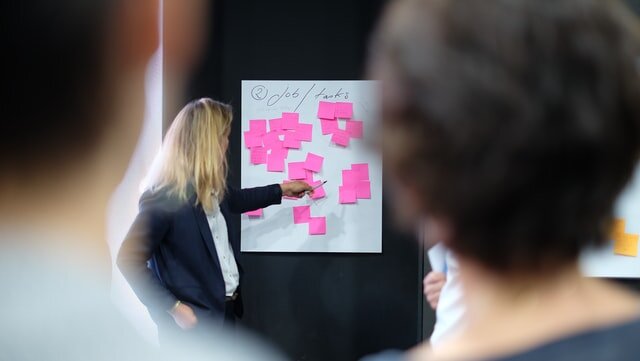A Fresh View on Innovation: An Interview with R. Nessensohn
Can innovation be taught? Are academic programs on innovation connected to the real world? What is the dream job for an innovation graduate? Robin Nessensohn, a Master student in innovation and entrepreneur shares his thoughts.
GK: You will soon graduate with a post-graduate degree in Organizational Innovation and Entrepreneurship. How connected was your academic innovation programme to the real world and the market?
Robin Nessensohn: This post-graduate Innovation and Entrepreneurship program offers a mix of theory and practice. The structure of the program is dual: On the one hand, it covers the theoretical frameworks and the history of innovation; On the other hand, it offers a more practical course where students are able to build their own little start-ups. In these more practical courses, we were teaming up in small groups in order to brainstorm ideas, conceptualize them, and develop prototypes.
We thereby used approaches such as Design Thinking in order to innovate in a customer-focused way. The program was thereby connected to the real world as we had to go out, interview people, and get feedback in order to further develop our idea. However, we did not actually go into the market with a product or service and so it was still rather conceptual.
GK: Do academic innovation programs focus primarily on innovation leadership? To what extend do they promote creative thinking and inventiveness? How do they ‘teach’ creativity?
RN: Innovativeness can be stimulated by enabling the right circumstances, thinking about how to bring the right people together, and how to communicate effectively in order to build on each other’s ideas. The concept of collaboration and communication was very important in the program and the theories were directly applied in our daily group work (e.g. how to listen and how to challenge ideas in a constructive way).
Creativity was thereby thought to be a result of the right structures. Following clear rules also when brainstorming creatively helps to create great results. For example, in a creative brainstorming phase, people are not allowed to criticize any idea, no matter how far-fetched it is. Then later there is a selection phase that has its own procedures. Also, when it comes to creativity it was strongly highlighted that this is often not the result of a single genius mind but the effect of bringing together a diverse group of people with different backgrounds and experiences.
GK: How innovative do you find these innovation programmes? Do their leaders introduce novel ways or new innovations to modernize them and make them more effective?
RN: I can only speak for our program but what I think is great about it is that they do take student opinion into account and adapt the program accordingly. Learning methods are diverse and thereby innovative, and the program offers some courses that you would generally not expect at a business school and, as a result, it seemed very innovative to me. For example, we had one course addressing the connection between art and innovation. While it might not be obvious how you could use such knowledge in a business context, I think it links back to the idea of creating diversity, which helps to have more novel ideas. Such courses give students a new point of view – one that they probably never had before and thereby enable them to see things with a different lens. Also, a course about the principles and the history of social science might be something you wouldn’t expect. Talking about things like “What is time?” and “What is space?” can be seen as very abstract but when diving deeper into the topic you realize how much you can learn from taking on such a new perspective and applying it to your daily life.
GK: Do you think that innovation can be taught or studied? Should be taught in high school? And if so, how?
RN: I do think that innovation can be taught to a certain extent. There are many frameworks and structured approaches that help to enable success when innovating and these things can be taught. But of course, innovation then still depends on the proactiveness and the ability of people to go out there, collaborate with others, and make things happen. I think that studying innovation definitely makes sense. Innovation is, to a large extent, based on human behavior, social dynamics, and knowledge management; and all of these things can be better understood when studying it.
Nevertheless, there will always be disruptive innovations that won’t be predicted just by studying innovation and I definitely don’t think that it is necessary to study innovation if you want to be an entrepreneur. Many people have great ideas and such a Master's program is just a way to get some new insights, some new points of view, and also serves as a platform to connect with other people who are interested in the topic of innovation and entrepreneurship.
GK: What is your favorite innovation definition?
RN: In my eyes, innovation is the creation of something new that creates value (this can be a product, a service, a new process, a new business model, and much more). The core aspect thereby is on the one hand that it is something new and on the other hand that it is not just an idea or an invention but that it is actually implemented and creates value for people.
GK: What is the ‘typical’ career ambition for an Innovation program graduate? What would be the ‘dream job’ for you?
RN: People from a program such as mine go in different directions. Most of them don’t directly start their own business but rather go into a corporation and work in areas such as R&D, project management, Strategy, or Product Management. Some of them also start their own business or work for already established start-ups. Others work for start-up accelerators or incubators and thereby also stay connected to the world of entrepreneurship.
GK: What skills would you list as essential skills for a successful innovation leader?
RN: I think the most important skills are people/ soft skills: Understanding people, bringing together people to form effective teams, leading diverse teams in an effective manner, enabling people to perform, and to work towards a common vision. Also, I think it is important to have a very open mindset and don’t think too narrow-minded when it comes to new ideas and new approaches.
This might sound straightforward but as humans, we are all to some extent reluctant to change and the openness towards change is therefore key. In order to have an impact, there is then also the necessity to be convincing and to be able to create a supportive network inside a company or a society in order to push for change and for innovations.
Robin Nessensohn is the Co-Founder of Really Good Innovation and a post-graduate student - pursuing an MSc degree in Organizational Innovation and Entrepreneurship at Copenhagen Business School.
Check also: our unique Innovation Toolkit - a collection of seven innovation templates that empower teams to frame problems, define product concepts, shape ideas, run hackathons, and more.
cover image by Dean Moriarty from Pixabay









MVPs and Startups - Why should a startup follow the MVP approach? How do you prioritize features? Answering these and other frequent questions people ask me about Minimum Viable Products - MVPs